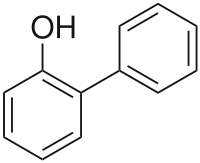- 2-Phenylphenol
-
2-Phenylphenol  2-phenylphenolOther nameso-phenylphenol
2-phenylphenolOther nameso-phenylphenol
biphenylol
2-hydroxybiphenyl
orthophenyl phenol
o-xenol
orthoxenolIdentifiers CAS number 90-43-7 
ChemSpider 13839012 
UNII D343Z75HT8 
KEGG D08367 
ChEBI CHEBI:17043 ChEMBL CHEMBL108829 
Jmol-3D images Image 1 - Oc2ccccc2c1ccccc1
Properties Molecular formula C12H10O Molar mass 170.21 g/mol Density 1.293 g/cm³ Melting point 55.5-57.5 °C
Boiling point 280-284 °C
 (verify) (what is:
(verify) (what is:  /
/ ?)
?)
Except where noted otherwise, data are given for materials in their standard state (at 25 °C, 100 kPa)Infobox references 2-Phenylphenol, or o-phenylphenol, is an organic compound that consists of two linked benzene rings and a phenolic hydroxyl group. It is a white or buff-colored, flaky crystalline solid with a melting point of about 57 °C. It is a biocide used as a preservative under the trade names Dowicide, Torsite, Preventol, Nipacide and many others.
Uses
The primary use of 2-phenylphenol is as an agricultural fungicide. It is generally applied post-harvest. It is a fungicide used for waxing citrus fruits. As a food additive, it has E number E231.
It is also used for disinfection of seed boxes. It is a general surface disinfectant, used in households, hospitals, nursing homes, farms, laundries, barber shops, and food processing plants. It can be used on fibers and other materials. It is used to disinfect hospital and veterinary equipment. Other uses are in rubber industry and as a laboratory reagent. It is also used in the manufacture of other fungicides, dye stuffs, resins and rubber chemicals.
2-Phenylphenol is found in low concentrations in some household products such as spray disinfectants and aerosol or spray underarm deodorants.
Eye contact can cause severe irritation and burns with possible eye damage. For some individuals, 2-phenylphenol can also irritate the skin. It is one of the chemicals that the Hyperactive Children's Support Group recommends be eliminated from the diet of children.
The sodium salt of orthophenyl phenol, sodium orthophenyl phenol, is a preservative, used to treat the surface of citrus fruits to prolong shelf life. As a food additive, it has the E number E232.
References
- Merck Index, 12th Edition, 7458.
- Merck Index, 13th Edition, 7388.
- Hazardous Substance Fact Sheet
External links
Categories:- Phenols
- Household chemicals
- Fungicides
- Antiseptics
- Fumigants
- Preservatives
- Biphenyls
Wikimedia Foundation. 2010.
